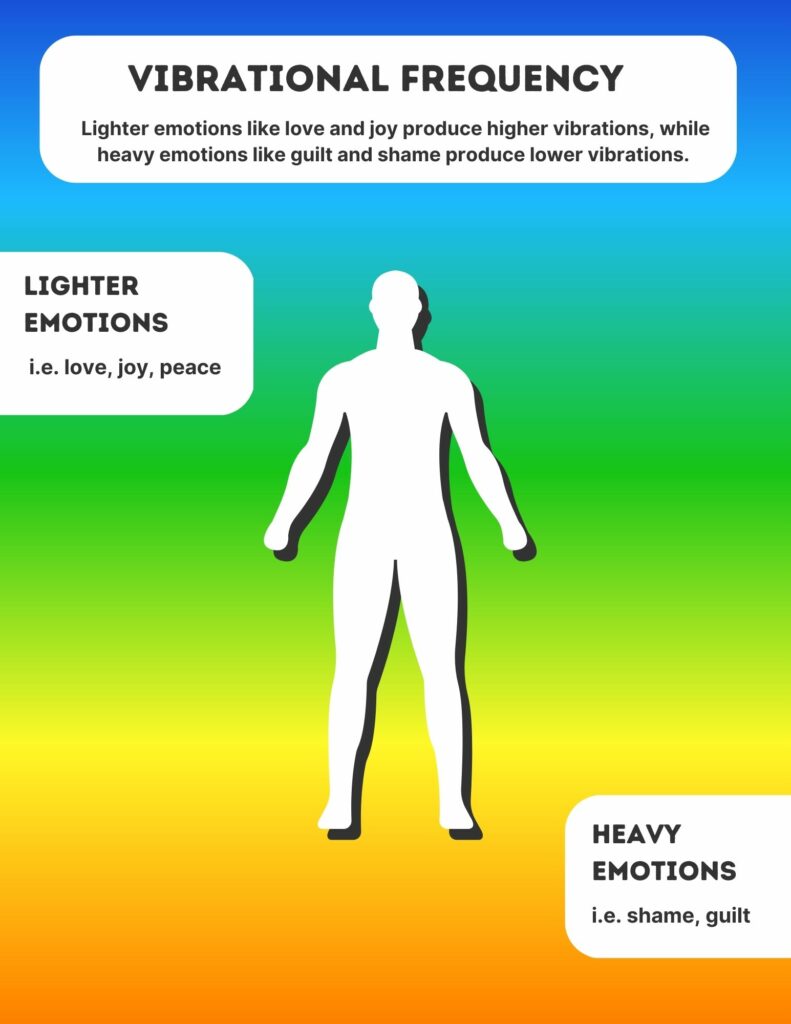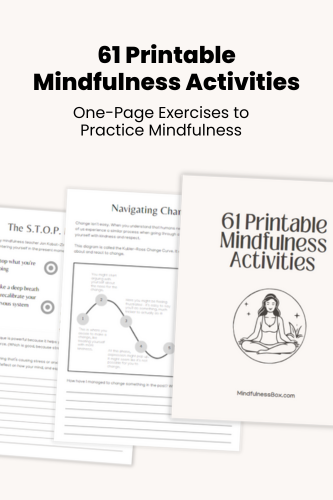The Emotional Vibration Chart maps the range of human emotions to higher and lower frequencies. Peace and joy are higher vibration emotions, while shame and guilt are lower vibration emotions. By using the chart, you can understand which emotions are “higher vibration” and start to cultivate more of those in your life.
You’ve heard people talk about good vibrations, high vibrations, and low vibrations.
Is this just a saying, or is there something more to it?
Get dozens of one-page exercises to help practice mindfulness, meditation, gratitude, and self love. Perfect for printable handouts when teaching mindfulness to groups, students, or in the workplace.
To see examples, plus a full list of the 61 exercises included, click below.
We’ve all had moments of joy and excitement where our experience has felt utterly different than those moments of boredom, frustration, and guilt.
The goal is to help identify where you are on the spectrum based on the emotion you’re currently experiencing. From there, you can reach for a higher vibrational state.
Let’s explore more about emotional frequency and how you can use these tools to improve your life.
Understanding the vibration scale of emotions
Keep in mind that although vibrations and frequency sound scientific, this isn’t science. There’s currently no research-backed way to measure the frequencies of emotions.
Rather, this is a tool from the world of spiritual development.
The concepts behind the “emotional frequency chart” originated with Dr. David R. Hawkins and his book Power vs. Force. Learn more at Dr. Hawkins’ publisher’s website.
The concept was further popularized in a book by Abraham Hicks called “Ask and It Is Given.”
The essence of the emotional vibration scale is this: Each human emotion receives a “frequency” based on whether it cultivates a primarily positive or negative mindset.
For example, joy, love, passion, and happiness are some of the highest-frequency emotions. Fear, anger, grief, guilt, and jealousy are common low frequency emotions.
Can you measure the frequency of emotions?
No.
It’s best to understand this as a relative tool to compare the positive and negative feelings generated by each emotion.
There is currently no research-backed way to measure the frequency of human emotions, although the hertz vibration scale may provide a way to do so in the future.
That being said, this hierarchy of human emotions can be a practical tool to pull yourself towards emotions on the higher end of the spectrum.
The emotional vibration chart
The emotional vibration chart is a way of conceptualizing higher vibration and lower vibration emotions.
Here’s what it looks like:

How do you use a vibrational chart?
To use the emotional frequency chart, your goal is to identify where you land on the spectrum of emotions, and set your sights on moving gradually up.
For example, if you’re currently experiencing significant shame, you’ll find yourself at the bottom of the chart. Shame is the lowest frequency.
Your goal should be to move upwards on the chart, but you can’t expect yourself to jump straight from shame to joy. That’s not realistic, and attempting to do so will feel inauthentic.
Instead, give yourself permission to reach for the next highest rung on the chart. Even moving from shame to apathy is progress, because once you’ve established yourself more fully in an apathetic state, you can move towards neutrality and eventually, joy.
You might notice echoes of the five stages of grief: denial, anger, bargaining, depression, and acceptance.
Just as you can’t expect to jump straight to acceptance after a traumatic event happens, you can’t expect to feel joy directly after experiencing guilt or shame.
The emotional vibration chart is a tool to help you navigate this path.
How to raise your vibrational frequency

Learning how to increase your frequency may take time, so first of all, give yourself permission to count small changes as victories.
A path toward increasing your vibrational frequency might look something like this:
- Set the right expectations. Remember that jumping straight from shame to joy isn’t a realistic path, and it won’t feel authentic. Instead, identify what your current emotion is, and consider what activities can help you move into a state of slightly higher vibrations.
- Do high vibrational activities. Starting your day with activities like exercise, gratitude, meditation, journaling, and being in nature can set you on the right path to nudging your vibrational frequency higher each day. Pro tip: sign up for something recurring, like a spiritual subscription box, to automatically remind yourself of your commitment to living lighter.
- Be around high vibrational people. The people you’re around are highly influential to your mood and state of being. The more time you can spend around people who “vibrate” at a higher emotional frequency, the better. How can you identify high vibration people? Listen to your intuition.
- Practice gratitude. Gratitude is a powerful emotion. It can convert frustration and scarcity to acceptance and abundance. Start practicing daily to build your gratitude muscle. With practice, your first reaction will be gratitude. (Check out 31 Days to Gratitude for help with this).
- Help others. When you’re not sure how to move yourself into a higher vibrational state, it always pays to think about what you can do for others. As Mahatma Gandhi said, “The best way to find yourself is to lose yourself in the service of others.”
- Make time to play. When was the last time you acted like a five year old? Like, running around in the rain, getting muddy-level play? Figure out what your inner child wants and make more time for playful activities.
- Understand that progress isn’t linear. The point of the vibration frequency chart isn’t that we’ll only go higher. Life is still a roller coaster, and your emotions will be rocky, too. We all have good days and bad days. Remember that when you find yourself experiencing difficult emotions.
The “Raise Your Vibrations” Journal
The 31-Day Raise Your Vibrations Journal guides you towards activities and mindsets that move you toward lighter emotions (like joy) and away from heavy emotions (like shame and anger). It includes daily prompts and weekly reflections intended to help you cultivate higher vibrations in your life.
Print it and fill it out as you go. Use this journal as a physical reminder of your commitment to yourself to focus on mindfulness for a full month.
A set of printable journals, toolkits, and affirmation cards designed to help you raise your vibrations over the course of one month.
- 31-Day Raise Your Vibrations Journal: Guides you towards activities and mindsets that move you toward lighter emotions (like joy) and away from heavy emotions (like shame and anger)
- 31 Raise Your Vibrations Affirmations Cards: 31 cards featuring affirmations to help you raise your vibrations each day.
- Pinpoint Your Emotions: Learn to pinpoint the exact emotions you're feeling. Understanding your current emotional state makes it easier to understand what you need to do next to raise your vibrations.
Incorporating emotional vibrations into your life

We’re not all likely to walk around with a emotional frequency scale in our pocket, referencing it as we go about our day.
Instead, think of this concept as a tool you can internalize the next time you’re in a low vibrational state.
Rather than personalizing it (“I feel shame, and I deserve to feel awful”), think about how you can move slightly higher up on the chart (“I’m going to do yoga, even though I feel apathetic about it, because that’s the next step up to feeling higher vibrations again.”)
A higher vibrational life comes not just from mindset but from activities and connections.
Think about how you can fill your days with less of the stuff that frustrates you, bores you, and makes you angry; and more of the stuff that excites you, makes you joyful, and brings you peace.
Whether that means building out a yoga or meditation practice or simply making more time to play as if you were a child again, find out what those activities are for you, and do them!
Further reading
- 5 Ways to Turn Around a Bad Day
- How to Get In Touch With Your Emotions
- How to Find Happiness Within Yourself
Frequently Asked Questions
Is anger a low vibration?
Yes. Anger is one of the lowest vibration emotions.
Do emotions vibrate at different frequencies?
Emotions don’t vibrate in a scientifically reproducible or research-backed way, although the hertz vibration scale may provide a way to do so in the future. Emotional vibrations are a concept from the world of spiritual development.
Some in the world of spiritual development suggest that being exposed to the Schumann resonance (Earth’s “natural frequency” of 7.83hz) helps to nudge your vibrations in a positive direction, although this is not backed by science.
What is the vibrational frequency of love?
Love is one of the highest vibration emotions.
How do you know if you have a high vibration?
There isn’t a scientific way to measure if you have a high emotional vibration, and you aren’t a “high vibration person” or a “low vibration person.” Just like moods, vibrations change depending on how you feel during any given day or moment.
However, if you’re feeling primarily feelings of peace, joy, and love, it’s likely you’re experiencing high vibrations. If you’re feeling primarily feelings of apathy, guilt, or shame, you’re likely experiencing low vibrations.
What emotions are high vibrations?
The highest human vibration frequency emotions are peace, joy, and love; the highest vibrational frequency can be attained by cultivating those emotions.
What is the lowest vibration emotion?
The lowest vibration emotion is shame. Other low vibrational emotions include disgust, anger, and envy.
What is a spiritual vibration chart?
A spiritual vibration chart is similar to a vibrational frequency chart, in that it’s a way to assess the relative heaviness and lightness of emotions. Shame, for example, falls low on the spiritual frequency chart, while generosity and joy rank higher.

My mindfulness practice kicked off in 2016 with a ten-day silent retreat. Since then, I’ve read dozens of books about mindfulness and completed hundreds of hours of meditation. Thinking about what makes humans happy, calm, and peaceful is endlessly fascinating to me.



